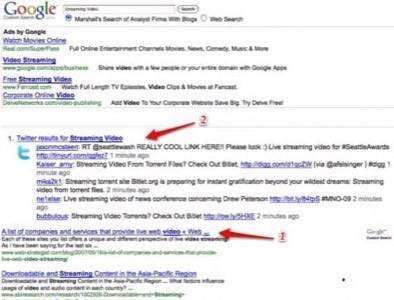Google launched its version of integrated real-time search, one of a number of impressive product demos given, at a press event this morning. It’s much better than what Bing and Yahoo! have done, but it’s still just the beginning of a full-scale engagement with the real-time web. To provide further context to this discussion, we’re rerunning a post we wrote in seven months ago, titled “3 Models of Value in the Real-Time Web.” We hope you find it useful and interesting.

Hey web DJ. Reach into your magic bag of search tools and pull out a big result – dripping with related ephemera born just moments ago. Those could hold the grain of information you’re really looking for, or they could sparkle with data that changes your course of action in unexpected ways.
Alert! Another factor has emerged, elsewhere on another site. You said you wanted to be told, right away, about any online artifacts that crossed a threshold of popularity within a certain group of people in your field. That has just occurred, so it’s time to watch the replay of how it got so hot, evaluate its usefulness and decide whether to bring this emergent phenomenon into the work you were doing before you were interrupted, drop the former for the latter or return to your original focus. How would you like this to be your job description? It could well be – if the red hot Real Time Web keeps showing up on sites all around the internet.
The Real Time Web is coming so fast we’ve hardly had any time to think about it yet. So let’s do that, shall we? The two hottest technologies online, Twitter and Facebook, are fast integrating real-time delivery of activity streams to their users. Paul Buchheit, the man who built the first versions of both Gmail and Adsense, says the real time web is going to be the next big thing. Buchheit’s FriendFeed is a key point of innovation in real time. Social media ping server Gnip promised to turn everything online into Instant Messaging-style XMPP feeds, and though that’s been put on hold in favor of more immediately clear value – we’ve still got our fingers crossed. Our investigation of companies like Bit.ly and OneRiot this morning turned up even more big news that’s right around the corner for the Real Time Web.
But what’s the point? What’s in it for us, as users? We offer below three models of value that we suspect will be found in the Real Time Web. They are the concepts that underly the vision described above at the top of this post. Those concepts are Ambiance, Automation and Emergence. This is just an initial exploration of ideas, reality will undoubtedly be more complicated shortly. We welcome your participation in thinking about this part of the fast-approaching future of the web.
Ambiance
The web is made up of web pages linked together, but hovering around many of those pages are now social media signals like blog posts, bookmarks, tweets and other URLs that refer to a page but aren’t visible when you’re looking at it. The same is true for concepts. Most of us use Google to find pages about things we’re looking for, but Google prioritizes historical inbound links and the text on pages.

In the above image you can see a custom search engine we use here at ReadWriteWeb, with Mark Carey’s Twitter on Google greasemonkey script running on top of it. If you want to know about streaming video, Forrester’s, Jeremiah Owyang, has a running list of vendors in the space (1) and that’s where you want to start – but wouldn’t you like to know about the very freshest (2) live streaming vendors on the market as well? That’s what people are talking about, in real time, on Twitter.
In our experience these Twitter augmented search results are valuable because they are up to the minute – but sometimes they are also just better.
Someday you’ll be able to discover Owyang’s list and be prompted to view the most recent, the most authoritative and the most “socially relevant to you” conversations about the same concept going on all around the web. People are working on all of that and as research-lovers we hope they succeed.
The point is that no matter what you’re doing on the web, there are valuable related activities going on elsewhere – probably simultaneously. Exposing those is exciting.
Automation
We probably should have started out with this, but what’s the most obviously valuable example of clear value in real-time information delivery in recent internet history? Blackberry and the push email!
We tend to assume that the real time web is something we’ll be looking at constantly, because it’s constantly bringing up new information. That doesn’t have to be the case, though. The real time web could very well just do its thing and notify us, in real time, of important events. Thresholds crossed. Simple changes made.
For example, when the already controversial Google Chrome Terms of Service were changed again last December, I got an SMS sent to my phone notifying me that it had been changed. I was able to jump online, grab a screenshot of the changes from the application that was monitoring the document and report on the change before anyone else.

I certainly wasn’t watching for the change. A robot was doing that for me and let me know about the change in near real time. It was pretty awesome, but it wasn’t real time and the services I patched together to do it are all marginal enough that they often don’t work or are very late. Put real time at the center of the web and we’ll be able to automate all kinds of information monitoring. At first it will be a competitive advantage for those who use it strategically; then it will just change the game, become standard practice and require competitive knowledge workers to come up with something else that’s new.
Read the last section of this post and the comments readers left here: 3 Models of Value in the Real-Time Web






















